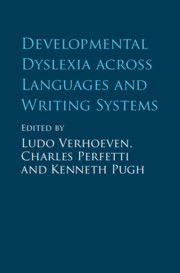Book contents
- Developmental Dyslexia across Languages and Writing Systems
- Developmental Dyslexia across Languages and Writing Systems
- Copyright page
- Contents
- Figures
- Tables
- Contributors
- 1 Introduction
- Part I Developmental Dyslexia across Languages and Writing Systems
- Part II Cross-Linguistic Perspectives on Developmental Dyslexia
- 11 Behavioral Precursors of Developmental Dyslexia
- 12 Neural Predictors of Developmental Dyslexia
- 13 Neurocognitive Markers of Developmental Dyslexia
- 14 Role of Visual Attention in Developmental Dyslexia
- 15 Morphological and Semantic Processing in Developmental Dyslexia
- 16 Modeling the Variability of Developmental Dyslexia
- 17 Modeling Developmental Dyslexia across Languages and Writing Systems
- 18 Etiology of Developmental Dyslexia
- 19 Intergenerational Transmission in Developmental Dyslexia
- Epilogue
- Index
- References
13 - Neurocognitive Markers of Developmental Dyslexia
from Part II - Cross-Linguistic Perspectives on Developmental Dyslexia
Published online by Cambridge University Press: 27 September 2019
- Developmental Dyslexia across Languages and Writing Systems
- Developmental Dyslexia across Languages and Writing Systems
- Copyright page
- Contents
- Figures
- Tables
- Contributors
- 1 Introduction
- Part I Developmental Dyslexia across Languages and Writing Systems
- Part II Cross-Linguistic Perspectives on Developmental Dyslexia
- 11 Behavioral Precursors of Developmental Dyslexia
- 12 Neural Predictors of Developmental Dyslexia
- 13 Neurocognitive Markers of Developmental Dyslexia
- 14 Role of Visual Attention in Developmental Dyslexia
- 15 Morphological and Semantic Processing in Developmental Dyslexia
- 16 Modeling the Variability of Developmental Dyslexia
- 17 Modeling Developmental Dyslexia across Languages and Writing Systems
- 18 Etiology of Developmental Dyslexia
- 19 Intergenerational Transmission in Developmental Dyslexia
- Epilogue
- Index
- References
Summary
In the history of human evolution, reading and writing skills were developed about 5,400 years ago (Dehaene, 2009), which is fairly late in the context of the 350,000–150,000 years of history of human speech (Perreault & Mathew, 2012). In terms of ontogeny, the acquisition of reading also follows that of speech over the course of the child’s early years. Nonetheless, reading has become one of the most important cognitive functions for daily life and reading difficulties can severely limit an individual’s ability to thrive in the modern world (Calfee, 1982; Rawson, 1978). Across languages and cultures, approximately 5–20 percent of the population (depending on definitional criteria) is affected by developmental dyslexia (DD), a specific reading impairment presents in the absence of other cognitive impairments (S. E. Shaywitz & Shaywitz, 2003).
- Type
- Chapter
- Information
- Developmental Dyslexia across Languages and Writing Systems , pp. 277 - 306Publisher: Cambridge University PressPrint publication year: 2019
References
- 1
- Cited by

